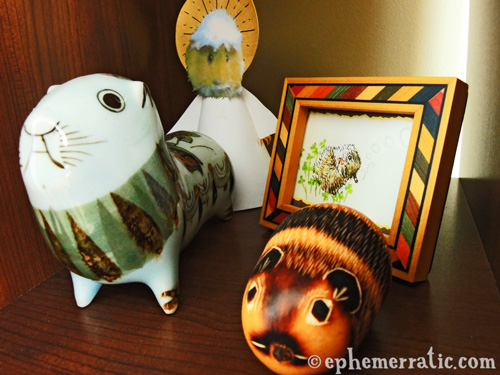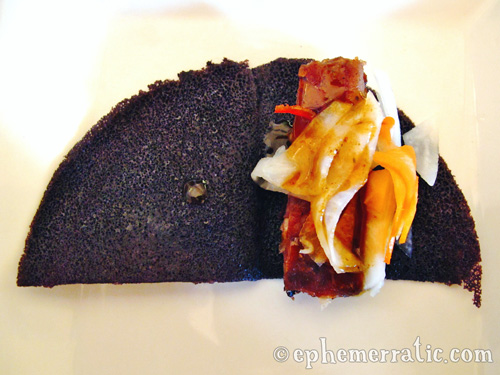Eating guinea pig: A pet at home, dinner in Peru
An old saying begins, “If you love somebody, let them go.” If you’re traveling to Peru and you’ve had a guinea pig as a pet, a more fitting expression may be, “If you’ve loved something, put it in your belly.”

Our best photo of our feral guinea pig
The guinea pig my husband Todd and I had wasn’t a pet, not precisely. He was feral, living free in our urban San Francisco backyard, a bucolic vision so unbelievable that a friend accused us of pulling his leg until he saw the guinea pig for himself.
But the guinea pig was real, an escaped pet from some neighbor kids, happily roaming wild in ours and a few adjoining yards. He had a white burst of head hair, a cross between Donald Trump’s toupée and Einstein’s electric hairdo.
We named him “Guillermo Ferál,” a Latinoized play on Will Ferrell, perfect for a Mission District guinea pig with a lot of body hair. Over time, Guillermo got so accustomed to us that we could feed him by hand, if he was in the mood.
Guillermo the guinea pig lived nearly two years free and easy, getting fat on sprouts and complacent from his cushy digs. And eventually he got old, slow, and even a little dumb — a very vulnerable combination for a feral fur ball.
One rare warm San Francisco night, when Todd and I just happened to be home with the windows open wide, we heard a pained screech followed by a frantic whimpering. We vaulted over furniture in our rush to race into our backyard, arriving in time to see a flash of furry white disappear through a hole in a very high and otherwise solid and unclimbable wooden fence. Guillermo had been carried off by a raccoon, caught out in the open during a reckless late-night graze.
For what was only minutes but felt much longer, the whimpering continued along with sounds of tearing. Then the whimpering diminished. Then it stopped. A few days later, our neighbor found some small bones and wads of fur.

What, doesn’t everyone have a guinea pig shrine in their home?
Guillermo died several years ago. After such a tragic end to our feral friend, you’d think that Todd and I wouldn’t be able to bear to eat guinea pig during our travels to Peru, where it’s a common protein source. But, like many Peru visitors, we wanted to try all the local specialties we could, including cuy (guinea pig), which was first bred as food in in the Peruvian Andes.
But, we couldn’t bring ourselves to order guinea pigs deep fried into an attack pose, claws and teeth bared, posed to shock and impress tourists, but so greasy and stringy from over-frying that they’re rarely eaten in their entire. Instead, we ate guinea pig in Ollantaytambo, a small town not far from Machu Picchu, deboned and stuffed with local vegetables then wrapped in bacon.

Cuy (guinea pig) roulade in Ollantaytambo, Peru.
We ate Cuy Pequinés (guinea pig Peking duck style) in Cusco at one of Gastón Acurio’s famous gastronomic restaurants, the skin pan-fried crisp, served with pliable pancakes made from maíz morado (dark purple Andean corn).

Gastón Acurio’s guinea pig, Cuy Pequinés, in Cusco, Peru.
Perhaps we paid too much for our frou frou Nuevo Andino-style guinea pig, but we wanted to try dishes by Peruvian chefs being creative with the heritage ingredient. Besides, if we were going to eat meat that reminded us of a furry friend, it needed to taste really good.

Bite of Gastón Acurio’s guinea pig, Cuy Pequinés, in Cusco, Peru.
The verdict: There’s nothing to fear about eating Peruvian cuy. The dark meat is a little fatty and gristly. To me, guinea pig meat was reminiscent of duck legs but with less gaminess, or chicken wings but with more gaminess. Eating guinea pig is an experience worth trying — if not to satisfy foodie inclinations, to taste a sustainable protein that sustains millions of people in South America every day.
The old saying continues, “If you love somebody, let them go, for if they return, they were always yours. If they don’t, they never were.” Guillermo was more wild than the guinea pigs in Peru, which are bred for domestication, portability, and nutritional value.
It turns our, eating guinea pig in Peru was easy because Guillermo was never actually ours.


We had attack-pose cuy in Cusco; it was so tough I gave up on it (I have trouble swallowing, so I’ve got to chew my meat carefully; I’d have had less trouble with my shoes.) I also didn’t care for the flavor; it reminded me of frog legs, which I don’t like even though I’m part-French. My girlfriend, on the other hand, liked the flavor, but also found it very tough.
I always thought that quote was “If you love something, set it free. If it comes back, it’s yours. If it doesn’t, hunt it down and kill it.”
Hilarious! I love your take on the quote. Clever Marc, very clever.
You’re making me even more glad that we opted out of that approach to eating guinea pig in Peru. Sounds like you were served exactly the preparation I feared finding.
But we’ll have to differ on frog legs. I’ve really enjoyed them prepared in a Szechuan Chinese stew or fried up in a Thai chili dish. Maybe give frog legs another shot if you can find it prepared one of those ways!
I took a picture, of course…
http://imgur.com/oZqSDo1
It looks even worse, in hindsight.
Oh my GAH! That is…clearly inedible.
That is going to be in my nightmares tonight. I’m not sure if it will be chasing me through Incan ruins or forcing me to chew it at gunpoint, but I have no doubt your cuy frito will haunt me.
Almost everything we ate and drank in Peru was amazing; it was by far the most gastronomically amazing trip we’ve been on… but that meal defeated me.
Incidentally, we took acetazolamide as prophylaxis against soroche all the time we were in the Andes, and it played havoc with my guts. I took to calling it “Pachacuti’s revenge”, and when I felt the first rumblings I would raise my arms to heaven and yell PACHACUTIIIIII!!!! like Kirk yelling KHAAAAAAN!!!! If it hadn’t been for that, I suspect I’d’ve gained ten pounds on the trip – everything (except cuy) was so good.
I am now imagining Kirk running around the Cusco cobblestone streets, in uniform, screaming PACHACUTIIIIII!!!! while holding his bum. < Awesome!
I probably would have gained weight if not for the incessant walking and trekking we did. There was always another street or mountaintop set of ruins to explore.
I ate guinea pig in Cusco, but I’m ashamed to say I specifically requested that it looked as much like the live version as possible. You missed out on the claw – that was the best bit…
Seriously? The claw? Even if I had ordered a whole guinea pig, I’m not sure that it would have occurred to me to eat the claw. Much as I used to overlook fish cheeks until someone pointed out that they are the most nom part.
Also, now you have me thinking of Inspector Gadget. Doctor Claw!
NPR’s “The Salt” blog has a bit on cuy today:
http://www.npr.org/blogs/thesalt/2013/03/12/174105739/from-pets-to-plates-why-more-people-are-eating-guinea-pigs
Also (I’m ashamed I didn’t think of this at the time) the perfect soundtrack for eating attack-pose guinea pig: “(She’s a) Killer Cuy”…
http://www.youtube.com/watch?v=BAf2S6ij2gk
LOL. I just read your comment to Todd and you got an appreciative groan for the Queen/cuy pun. Todd’s a pun master (seriously: he told the most crab puns during an all-you-can-eat crab fest), so that’s a big compliment!
hi Guys I loved reading your comments and Marc you made my husband and I laugh with the new take on setting things free.
We live way down under in New Zealand where most things are free. We have about 20 feral Guinea pigs in our garden. We live on a farm so no cats or roaming predators. Our 2 Chihauhaus treat them as part of the family and don’t chase them. They live as a large community and we feed them each morning on a tray of Rabbit and Guinea Pig pellets. They keep our lawn down and well manicured. great fun. Sharmenl